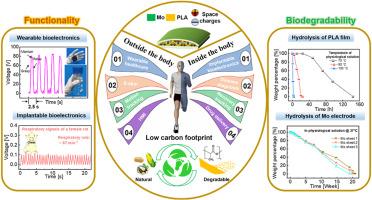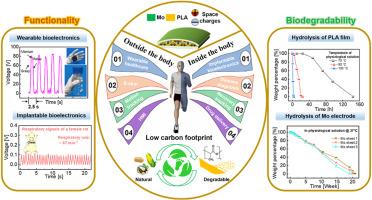Fully degradable, highly sensitive pressure sensor based on bipolar electret for biomechanical signal monitoring
IF 10
2区 材料科学
Q1 MATERIALS SCIENCE, MULTIDISCIPLINARY
引用次数: 0
Abstract
In view of the global ecosystem crisis resulting from the ubiquitous electronic waste (e− and plastic waste), the engineering of advanced electronic devices from sustainable materials is gaining considerable attention. Nevertheless, the development of advanced, maybe even degradable electronics with comparable or even improved functionality remains a great challenge. In this article a fabrication process for a fully degradable, highly sensitive pressure sensor based on electrets is proposed enabling the creation of a universal platform for monitoring various biomechanical signals. The high sensitivity of the proposed biomechanical electret-based sensor utilizes electrostatic induction of highly deformable cellular polylactic acid (PLA) films with a serrated ripple structure and an improved bipolar charge storage capability. This biodegradable pressure sensor possesses competitive mechanical signal detection performance, obtaining a high pressure sensitivity (10 V/kPa), robust working stability (∼30,000 continuous cycles), short electromechanical response/recovery time (∼17 ms), and satisfactory heat resistance up to 60 °C. By tailoring the thickness of the encapsulation layer, the functional lifetime of the biomechanical sensor in physiological environment can be controlled effectively, facilitating adaptability to various implantable application scenarios. Altogether, the present work not only proposes an effective fabrication process for high-performance pressure sensors, but also provides new insight into the design of sustainable electronics with controllable lifetime thereby minimizing their environmental footprint. The developed sensor promises great potential in monitoring multiple biomechanical signals inside and outside the human body (e.g., body movements and physiological activities) as well as an environment-friendly realization of green electronics.


基于双极驻极体的完全可降解、高灵敏度压力传感器,用于生物力学信号监测
鉴于无处不在的电子废物(电子垃圾和塑料垃圾)所造成的全球生态系统危机,利用可持续材料制造先进电子设备的工程技术正日益受到广泛关注。然而,要开发出功能相当甚至更强的先进甚至可降解电子器件,仍然是一项巨大的挑战。本文提出了一种基于电子管的完全可降解、高灵敏度压力传感器的制造工艺,从而能够创建一个用于监测各种生物力学信号的通用平台。这种基于驻极体的生物力学传感器具有高灵敏度,它利用静电感应产生具有锯齿波纹结构和改进的双极电荷存储能力的高变形细胞聚乳酸(PLA)薄膜。这种可生物降解的压力传感器具有极具竞争力的机械信号检测性能,可获得较高的压力灵敏度(10 V/kPa)、强大的工作稳定性(∼30,000 次连续循环)、较短的机电响应/恢复时间(∼17 ms)和令人满意的耐热性(最高可达 60 °C)。通过调整封装层的厚度,可以有效控制生物力学传感器在生理环境中的功能寿命,从而适应各种植入应用场景。总之,本研究不仅为高性能压力传感器提出了一种有效的制造工艺,而且为设计寿命可控的可持续电子器件提供了新的见解,从而最大限度地减少了对环境的影响。所开发的传感器在监测人体内外的多种生物力学信号(如身体运动和生理活动)以及实现绿色电子产品的环境友好性方面具有巨大潜力。
本文章由计算机程序翻译,如有差异,请以英文原文为准。
求助全文
约1分钟内获得全文
求助全文
来源期刊

Materials Today Physics
Materials Science-General Materials Science
CiteScore
14.00
自引率
7.80%
发文量
284
审稿时长
15 days
期刊介绍:
Materials Today Physics is a multi-disciplinary journal focused on the physics of materials, encompassing both the physical properties and materials synthesis. Operating at the interface of physics and materials science, this journal covers one of the largest and most dynamic fields within physical science. The forefront research in materials physics is driving advancements in new materials, uncovering new physics, and fostering novel applications at an unprecedented pace.
 求助内容:
求助内容: 应助结果提醒方式:
应助结果提醒方式:


